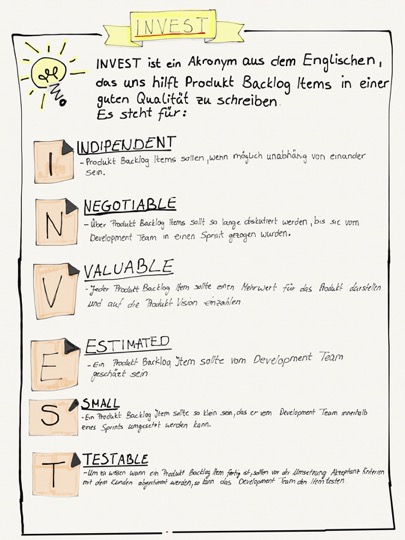Why do I need this flipchart?
Teams, product owners or stakeholders often ask "What are the characteristics of a good product backlog item?" The acronym INVEST can help to answer these questions. INVEST stands for Independent, Negotiable, Valuable, Estimated and Tested. In detail, it means the following.
I - Independent
To implement product backlog items incrementally, they must be selected in such a way that they are independent of each other. If many product backlog items are dependent on each other, this is an indication that the product backlog items are cut horizontally, as in the waterfall, and not vertically, which enables incremental delivery.
N - Negotiable
Negotiable stands for an invitation to Conversationto understand what is to be implemented, why this makes sense and how it contributes to the product vision. Basically, we talk about product backlog items and adapt them until they have been pulled into the sprint.
V - Valuable
Each product backlog item should contribute to the realization of the product vision or, in other words, it should generate added value for the product. It helps to ask: "Why do we need this product backlog item?" or "How exactly does it contribute to our product vision?"
E - Estimated
The product backlog item is estimated by the development team. In order to be able to estimate a product backlog item, the development team must understand what is wanted (this is where the N for Negotiable comes into play) and jointly provide an estimated value.
S - Small
Small applies above all to product backlog items that are higher up in the backlog. These should be small enough that they can be implemented in a sprint. The estimated value from the team is an indicator of when an item is small enough for a sprint.
T - Testable
Implemented product backlog items should be accepted as complete. To ensure this, the product owner and development team must understand the criteria under which the stakeholder accepts the product backlog item. These criteria should be jointly agreed and documented before implementation; they are often referred to as acceptance criteria. Based on these criteria, the development team can test the product backlog item.
Conclusion
Basically, the last three criteria, Estimatable, Small and Testable, are indicators of when a product backlog item is ready for a sprint. For many Scrum teams, these criteria can also be found in the Definition of Ready.


Comments
Write a comment